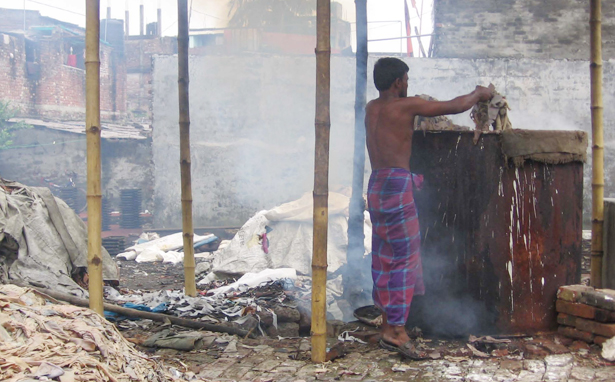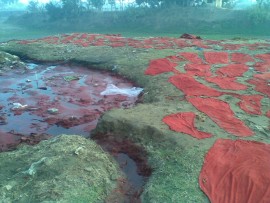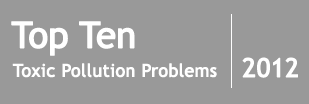Source #4
Tanneries
Description
Tanning is a set of processes that turns animal hides into leather appropriate for making a range of consumer products. Tannery processes treat raw animal hides to remove hair and leftover animal parts, stabilize the hides so they do not decompose and then dye or treat them to create a finished product. Products include belts, shoes, clothing, pocketbooks and additional consumer items. These processes are done in many steps using many different types of chemical and mechanical means.[1] Sulfides are used to break down the hair and chlorides are used in the pickling or preservation process. Of particular concern is the use of chromate salts in the stabilization process, because, unless well-controlled, hazardous chromium wastes and chromium-contaminated wastewater can be released. In addition to these chemicals, massive amounts of water are used in the process.[2] Up to 30 or 40 cubic meters of wastewater is created per ton of raw material processed.[3]

Most tanning operations are regulated and have pollution controls in place but there are still many small tanneries operating under primitive conditions with little controls. There are over 100 sites polluted by tannery operations in the Blacksmith Institute’s database, potentially putting more than 1.8 million people at risk. These sites mostly consist of contaminated legacy tannery sites or smaller, poorly run facilities. These smaller scale tanneries will continue to operate as the consumer demand for leather goods grows, as leather tanning provides a good employment opportunity in low and middle-income countries. For example, in India in 2011, 75 percent of leather tanneries were small-scale operations.[4] These smaller industry sites are often under regulated, not well managed, and cannot afford the substantial pollutant control mechanisms that are needed to deal with the large amounts of waste.
Exposure Pathways
The tanning processes use various chemical solutions and create large volumes of wastewater, together with solid waste and sludge. Untreated wastewater can contain acidic and alkaline water, pesticides and insecticides, animal pathogens and most notably, may have chromium levels up to 100–400 milligrams per liter.[5] Solid waste can include skins, hides or hair and chromium-contaminated sludge waste, or mixed waste with a combination of all of these. Waste is often released through direct dumping or by improper disposal in unprotected dumpsites. Pollutants leach into the groundwater and are absorbed by the soil. The main pathways for human exposure to pollutants from tanneries in the database are ingestion of contaminated food and water.
Top Pollutant(s)
Chromium is the most pervasive and hazardous pollutant found in tannery processes. Trivalent chromium is used as part of the re-tanning process and is washed off from leathers during the dyeing processes and is present in the wastewater of tanneries in significant amounts.[6] Trivalent chromium is not highly toxic but can, under anthropogenic activity, using a strong oxidant factor, be converted into hexavalent chromium. Hexavalent chromium is found at a number of polluted tannery sites in the Blacksmith Institute’s database and is a carcinogen that causes lung cancer and potentially increases the risk of stomach cancer when ingested.
Global Burden of Disease
Blacksmith Institute estimates that exposure to hexavalent chromium from tanneries results in some 1.8 million DALYs, the fourth largest single pollutant contribution to DALYs in this report. Exposure to lead at tanneries also contributed 200,000 DALYs, for a total of almost 2 million DALYs from tanneries. The World’s Worst Pollution Problems 2012
What is being done?
Improving the standards and training for small-scale tanneries in low and middle-income countries could help prevent further contamination at these sites. If waste is treated, stored and disposed of properly the risk of pollution is much lower. For sites that are already polluted, remediation technologies are available to treat chromium pollution in soil and water.
Blacksmith Institute has successfully implemented programs to clean up and alleviate the impacts of chromium on human health and has found several cost-effective and efficient ways to address the problem. Kanpur is the ninth-largest city in India; its eastern districts feature about 350 industrial tanneries, many discharge untreated, chromium-filled waste into local groundwater sources and the Ganges River. Initial studies of the groundwater quality in Kanpur revealed chromium-6 levels of 6.2 mg/L; the Indian government places the limit at .05 mg/L. Blacksmith remediated the area using chemicals that neutralize the chromium, while implementing an education campaign warning locals of the hazards. For the awareness-raising campaign, Blacksmith supported Ecofriends, a local environmental NGO in Kanpur. For chemical remediation of the chromium, Blacksmith worked with Ecocycle/GZA (engineering consultants who supplied needed materials) and the Central Pollution Control Board in order to undertake the first such project in India’s history. Blacksmith also dug four new wells to monitor water and provide new water sources to the community. Two new submersible water pumps were installed to provide safe, potable drinking water. The chemical remediation project decreased levels of chromium-6 at all test sites, in some cases to undetectable levels.
Footnotes:
[1] “Tanning and Leather Finishing.” Pollution Prevent and Abatement Handbook. World Bank Group. 1998
[2] Bosnic, M. et al. “Pollutants in Tannery Effluents.” United Nations Industrial Development Organization. Regional Programme for Pollution Control in the Tanning Industry in Southeast Asia. 2000.
[3] Ingle, K.N et al. “Policy framework for formulating environmental management strategy for sustainable development of tanneries in India.” Environ Health Prev Med (2011) 16:123–128
[4] Ingle, K.N et al. “Policy framework for formulating environmental management strategy for sustainable development of tanneries in India.” Environ Health Prev Med (2011) 16:123–128
[5] Tanning and Leather Finishing”. Pollution Prevent and Abatement Handbook. World Bank Group. 1998
[6] Bosnic, M. et al. “Pollutants in Tannery Effluents.” United Nations Industrial Development Organization. Regional Programme for Pollution Control in the Tanning Industry in Southeast Asia. 2000.

-
Source #1
Battery Recycling
-
Source #2
Lead Smelting
-
Source #3
Mining and Ore Processing
-
Source #4
Tanneries
-
Source #5
Industrial/Municipal Dumpsites
-
Source #6
Industrial Estates
-
Source #7
Artisanal Gold Mining
-
Source #8
Product Manufacturing
-
Source #9
Chemical Manufacturing
-
Source #10
Dye Industry
-
The Remaining Five Sources



